| |
|
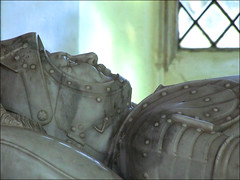 |
|
It was
May 2001, and I was cycling out across
the gently rolling acres of north
Suffolk. Redgrave is one
of those large and relatively
self-sufficient villages that you get
more in the north and west of Suffolk
than around Ipswich. However, this was
not apparent to me, as I approached it
from the direction of Wortham Common. I had
cycled through the Long Green, a strange,
otherworldly place. The Commons and
Greens around here were still, until half
a century ago, intensively grazed. Now,
they have been let go back to nature, and
are in many places covered in gorse and
furze, with outcroppings of angular
trees. Occasionally, as at Wortham, there are
settlements which seem carved out of the
common land. There’s nowhere else in
Suffolk quite like it. I left this behind, and a
deep cutting of a lane led me up and out
into open fields. The sun came out, and
the tower of St Mary was ahead of me. It
is a curious sight. Suffolk has a handful
of towers rebuilt in the 18th century.
Mostly, they are red brick, as at Layham, and rather less
successfully Grundisburgh. However,
Redgrave’s tower is white brick, and
would be quite at home in the City of
London, if a little more austere than
most there.
|
Attached
to it is a huge church. St Mary is big;
it is a little-known church, but has more to
offer than most. Simon Jenkins ignored it in England’s
Thousand Best Churches; most probably, he
didn’t know about it. It would fit quite
comfortably into his three star category along
with the likes of Westhall which he also missed.
Incidentally, when I met him and pointed out his
omission of Redgrave and Westhall, he looked at
me as if I was some kind of sad lunatic. I
suppose that he’s approached by someone with
a similar complaint at least twice a day.
I stepped inside to a vast space.
This church is full of light. The clerestory and
aisle windows are huge, and although the east
window is full of coloured glass, it too is vast,
one of the widest I've seen. It would take
hundreds and hundreds of people to fill this
place, more than a thousand perhaps; but it was a
gentle reminder to me that our medieval parish
churches were not built for congregational
Anglican worship.
St Mary has one of Suffolk's three
best brasses, the 1609 memorial to Anne Butts. It
has been reset in the sanctuary floor. She was
related to the Bacons, that mighty Suffolk
family, and her inscription reads:
The weaker sexes strongest
precedent
Lies here belowe; seaven fayer years she spent
In wedlock sage; and since that merry age
Sixty one years she lived a widowe sage
Humble as great as full of Grace as elde,
A second Anna had she but beheld
Christ in His flesh who now she glorious sees
Below that first in time, not in degrees.
Mortlock thought it the finest
post-Reformation brass in England.
To get to it, you will have to pass
an awesome table tomb in the north aisle. On it
lie, life-size, Sir Nicholas and Lady Anne Bacon.
Lady Anne was the daughter of Anne Butts (and Sir
Nicholas her son-in-law) so we may assume that
they are responsible for the quality of her
memorial. But the grandeur of theirs quite
outshines her, and everybody else. It is by
Nicholas Stone, famous for the Coke memorial at Bramfield; she died in 1616, he in
1624. There is an excellent modern window behind
it.
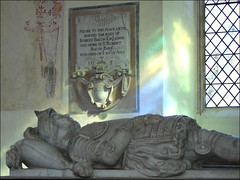  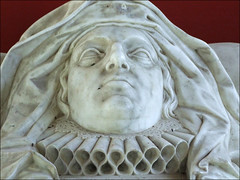
 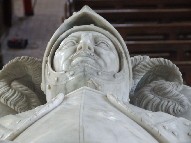 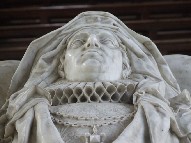 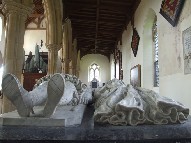
The Bacons are responsible for most
of the thirteen hatchments here - more than in
any other church in Suffolk. Others are for the
Holt and Wilson families (who later
intermarried). The latest is dated 1929. One of
the Holts can also be found up in the sanctuary.
In a remarkably grand memorial by Thomas Green of
Camberwell. He's life-size, as you might expect
here. Sir John Holt was Lord Chief Justice of
England and died in 1709. He sits in his judge's
robes, and he's flanked by the two voluptuous
figures of Justice and Mercy.
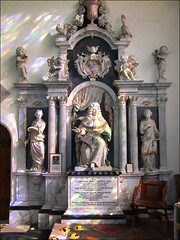 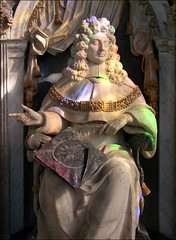
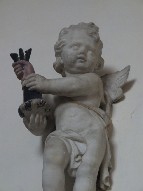  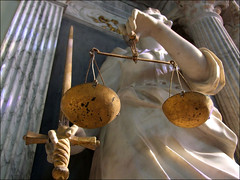 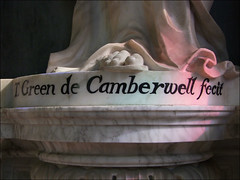 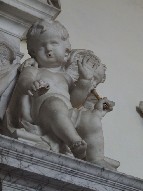
In this great palace of slightly
absurd grandeur, mention should also be made of
the vast wooden decalogue hanging in the north
aisle. I've never seen Moses and Aaron look so
important. It once stood at the east end of the
chancel, has ridiculously large scrolls, and
would certainly have concentrated the mind. All
of this is overseen by that lovely glass in the
huge east window. Mortlock tells us it is by a
local firm, Farrow and son of Diss. I thought it
splendid, quite in keeping with this mighty
place. Also in keeping is the white stone pulpit,
which is rather camp, although one assumes this
was not the intended effect.
In 2004,
three years after my first visit to Redgrave
church, the parish walked away from it. The cost
and effort of maintaining this vast barn full of
priceless treasures had become too great a burden
for the small congregation, so they locked the
doors and decamped to the village hall, declaring
that St Mary was now no longer their
responsibility. As you may imagine, this caused a
certain amount of consternation. While Redgrave
church is a building of national significance,
there is a certain protocol required if you want
to declare a building redundant and have it
conveyed into the stewardship of the Churches
Conservation Trust. Not being able to pay the
repair bills is not considered a good enough
reason to declare redundancy. Even so, the parish
persisted, which rather placed the Diocese in a
quandary. While their first responsibility was to
the parishioners, they clearly did not have the
resources needed to look after St Mary, and yet
the church commissioners would have looked with
some doubt on any attempt to declare the building
redundant.
It was, in
modern political parlance, uncharted territory.
Nevertheless, it was obvious that the ultimate
destination must be to ensure the future security
and upkeep of the building, and so after eighteen
months or so of what one imagines must have been
fairly tense meetings, the church was conveyed
into the care of the Churches Conservation Trust.
And in the
meantime, something else had happened. The shock
of the incident had galvanised some local people,
including a few of the former congregation, to
get together and form a group to look after St
Mary. With the support of the Churches
Conservation Trust this has become one of the
most successful support groups in the county,
putting on exhibitions and concerts for which the
church is eminently suitable. Before the end of
the decade, the Daily Telegraph
newspaper awarded Redgrave church the prize of
English Village Church of the Year. On that
occasion I was asked by BBC Radio Suffolk to do
an interview about the church while standing in
the nave, and as I looked around I thought it
seemed a happy ending.
In fact,
within a few months I was back at Redgrave church
for a quite exciting reason. The Eastern Daily
Press of 13th July 2010 takes up the story: It
had remained hidden for centuries. But the
entrance to a 500-year-old vault beneath a
medieval Suffolk church has been discovered after
a woman accidentally stamped her foot through one
of the floor tiles. While rehearsing a scene from
an upcoming performance of the musical Quasimodo
at St Mary's Church, in Redgrave, near Diss,
actor Kathy Mills dislodged a marble flagstone
near the altar and her foot disappeared into a
dark void below. Mrs Mills, who is in her 60s,
suffered a swollen ankle, but the pain soon
subsided when she was later told she had
uncovered a tomb never seen in living memory with
coffins inside suspected to contain the remains
of the village's past aristocracy.
Just weeks before a geophysicist had used an
advanced radar to map out where the
long-forgotten vault was, but if it was not for
Mrs Mills' freak accident they would never have
been certain of where its boarded-up entrance was
or what hid inside. The church is now hosting an
open weekend to give the public a chance to
glimpse through the hole and see exactly what
they've been walking above all these years. St
Mary's Church will be open to the public this
Saturday and Sunday, between 10am and 4pm, where
a video camera will beam images from inside the
vault onto a projector screen.
“I was just doing a rehearsal for the
production and I walked onto the flagstone,
whether it was already loose I'm not sure, but my
foot went down,” said Mrs Mills. “They
lifted it up (the flagstone) and you could just
see some mud and sand underneath. It's possible
my foot went down eight inches. I wondered where
I was going. It was quite a shock. I was thrilled
when they told me I had discovered this vault
they did not know was there. One or two people
call me the Tomb Raider.”
Rumours had circulated for decades that under the
ancient slabs of the 14th century church, now
owned by The Churches Conservation Trust, laid a
labyrinth of passages and tombs. Bob Hayward,
chairman of the Redgrave Church Heritage Trust,
said stories had passed through the generations
of how people walked through the tunnels as
recently as the 1920s, but records of their
existence cannot be found. In a bid to establish
fact from fiction, the group employed Malcolm
Weale, of Geofizz Ltd, from East Harling, near
Thetford, about two months ago to analyse what
lied below. Using a ground penetrating radar, Mr
Weale identified a large void, about 6ft deep,
spreading under the altar and into the adjacent
vestry. The Trust was prepared to leave its
investigations at that until the day of Mrs
Mills' fateful accident just over a week ago.
When the damaged flagstones were lifted and a
light was lowered down, a tunnel was discovered
with a set of steps descending into the ground
visible in one direction and a cluster of about
six coffins tucked inside a dark chamber in the
other. It appears timbers holding up the floor
tiles had rotted. Mr Hayward said: “It's
exciting. You think you know these places but you
don't until something like this happens.”
It is thought the coffins belong to descendents
of the Holt family. Sir John Holt became lord of
the manor in 1703 and a large memorial to his
life sits above the newly uncovered vault.
However it is believed to have been built in the
late 1500s by the Bacon family, but their remains
are located in another tomb beneath the church's
font. Archaeologists will be descending into the
vault at the end of the year to assess whether
any of the other supporting timbers are rotten
and to record what's inside, but the coffins will
remain as they are found.
Now, this
was something I had to see. The hole was about
20cm by 40cm. Bob Hayward very kindly opened it
up the hole for me and allowed me to lower my
camera into it - it wasn't safe to go down there,
because of the high concentration of carbon
monoxide.
 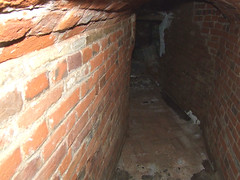
How exciting!
My photograph showed the high-vaulted tunnel of
18th Century brick, and in a room beyond there
were five lead coffins, almost directly under the
magnificent Holt memorial.
| This was
a fascinating experience, and all in all
St Mary is a fascinating church, one of
the best in East Anglia, despite what
that Jenkins book says. It is not
understated, it never attempts to be
tasteful or refined. After the thrill of
exploring the tunnel, I sat for a moment
on the steps leading up to the organ at
the west end, surveying the wonderful
brick floors, the expanses of light
beneath the arcades, the awesome
seriousness of the chancel. If, at that
moment, a group of 18th century ladies
and gentlemen had stepped out of a Samuel
Richardson novel and into this church, I
should not have been the least bit
surprised. And curiously, Redgrave
village is not the largest population
centre in the parish. That honour goes to
Botesdale, down on the main
road, and part of the extended village of
the Rickinghalls. Botesdale has its own church, but strictly
speaking it is a chapel of ease to this
one. The most famous residents of the
parish these days are not Bacons, Holts
or Wilsons, but the extremely rare great
raft spiders which live in Lopham fen, to
the north of the village. It is one of
only two places they are found in the
British Isles.
|
|
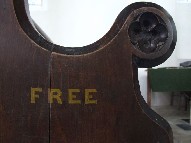 |
|
|
|

